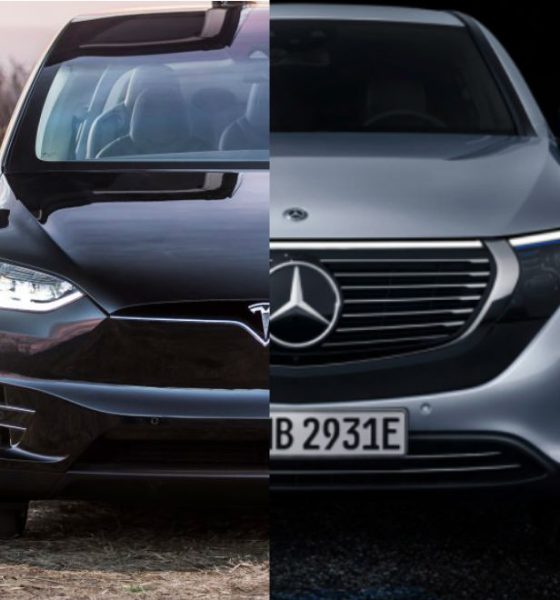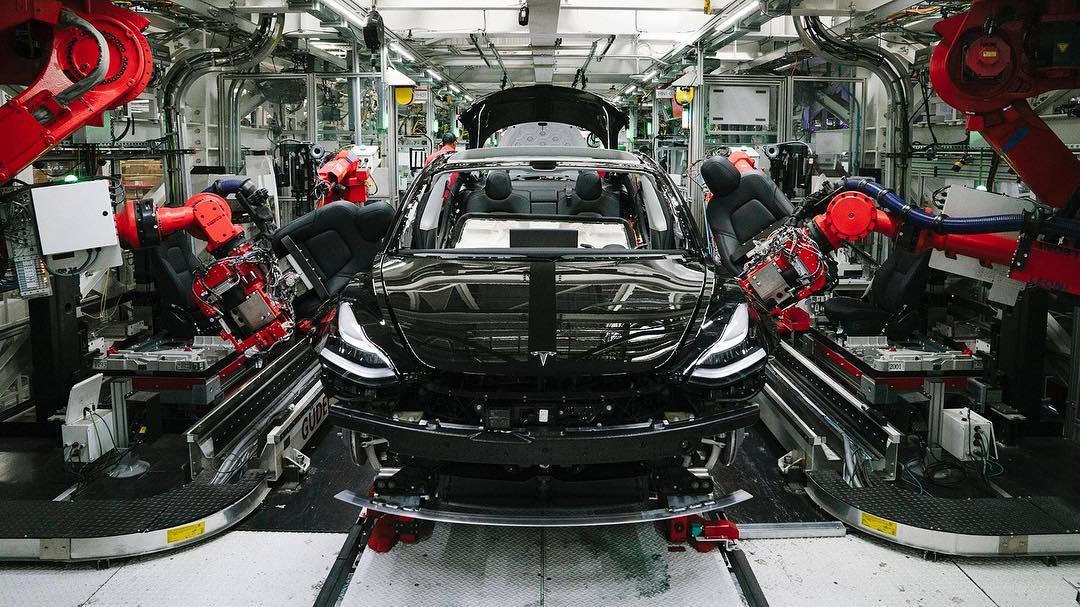

Investor's Corner
Tesla’s experience in electric cars emphasized anew after Mercedes EQC reveal
Earlier today, Tesla stock was given a Sell rating by Goldman Sachs, citing the arrival of competitors from established automakers. Some of these competitors are dubbed as “Tesla Killers,” such as the Jaguar I-PACE and the Mercedes-Benz EQC. The financial firm’s renewed Sell rating on Tesla appears to have affected the sentiment of some investors, resulting in TSLA stock ending the day down 4.21% at $288.95 per share.
Earlier today, the electric car industry also welcomed its latest vehicle from legacy automaker Mercedes-Benz. At an event in Stockholm, Sweden, Daimler AG Chief Executive Officer Dieter Zetsche unveiled the Mercedes-Benz EQC, an all-electric crossover SUV that symbolizes the company’s commitment to the upcoming electrification of the transport industry.
“There is no alternative to betting on electric cars, and we’re going all in. It is starting right now,” Zetsche said.
Mercedes-Benz tried hard with the EQC, with Zetsche stating that the vehicle will be profitable, and that it would “offer the best package” compared to rivals. The EQC also looks very much like a conventional Merc SUV, with its almost understated lines, its high ground clearance, and its tough stance. The EQC’s basic specs are quite decent, with two electric motors that produce 402 hp and 564 lb-ft of torque. The SUV can accelerate from 0-60 mph in 4.9 seconds and hit a top speed of around 112 mph. That being said, the Mercedes-Benz EQC’s range and production date ultimately prove that it won’t be so easy for legacy automakers to gain EV expertise that is comparable to Tesla’s.
The Mercedes-Benz EQC is equipped with an 80 kWh battery pack, which puts its size between the base Model X’s 75 kWh battery pack and the Jaguar I-PACE’s 90 kWh battery. Despite its generous battery size, the EQC’s estimated range is very conservative at around 200 miles per charge. Charging the vehicle from 10% to 80% is also estimated to take around 40 minutes. The EQC’s apparent lack of range has not gone unnoticed. Alex Roy, a veteran of the auto industry, for one, noted that the EQC’s range was a big “miss” for the established German automaker.

In a way, this could be attributed to Mercedes-Benz’s lack of experience in designing and building all-electric cars. And it’s not just Mercedes-Benz, either. Jaguar’s I-PACE is listed with a 240-mile range, but informal, real-world tests online have noted that the vehicle’s battery consumption is quite high. The same could be true for the EQC. It might have a big enough battery, but it could prove to be the electric equivalent of a gas guzzler.
This is something that Tesla has refined over the years. Elon Musk has opted to develop Tesla’s battery packs and even its software in-house, allowing the company to create vehicles that just work. In terms of range, Tesla’s cars usually come very close to their rated range, in some instances even exceeding it. Even the Model X 75D — one of Tesla’s largest, heaviest offerings — could go as far as 237 miles with a 75 kWh battery. Tesla’s progress in developing and building electric cars ultimately cannot be discounted, as Volkswagen AG, a prominent German automaker, was one of the investors willing to help fund Tesla’s attempted privatization.
Another notable detail from the Mercedes-Benz EQC’s unveiling that validated Tesla’s experience in building electric cars is the German-made SUV’s production timeline. Mercedes expects to start manufacturing the EQC sometime next year, with deliveries beginning in 2020. Compared to Tesla’s hyper-aggressive timetables, Mercedes-Benz’s timeline is very conservative, especially considering that the automaker is looking to build the EQC in some of its existing facilities.
A Tesla Model 3 being assembled.
There is very little doubt that Tesla is the company that ultimately made electric cars desirable, proving to consumers that battery-powered vehicles are actually realistic alternatives to fossil fuel-powered cars. Since starting the production of the Tesla Roadster, the company has gained a lot of experience, a lot of it coming from trial and error. Over the years, Tesla has refined its battery technology, to the point where the company is now attempting to hit a battery pack cost of $100 per kWh. Its 2170 cells that power the Model 3 are also proving to be impressive, with Detroit veteran Sandy Munro praising it as some of the finest batteries he has ever analyzed.
A central part of the Tesla Killer thesis is that competitors from established automakers can easily catch up and overtake the California-based company with vehicles that are far superior in quality and performance. If the range and estimated delivery date of the Mercedes-Benz EQC are any indication, it appears that the arrival of these competitors might be just a little bit too late. After all, by 2020, Tesla is planning to start the production of the next-generation Tesla Roadster, a supercar to end all supercars. The Tesla Model Y, a CUV expected to be even more popular than the Model 3, would likely be in production by then as well.
Watch the Mercedes-Benz EQC’s unveiling in the video below.

Investor's Corner
Tesla stock closes at all-time high on heels of Robotaxi progress

Tesla stock (NASDAQ: TSLA) closed at an all-time high on Tuesday, jumping over 3 percent during the day and finishing at $489.88.
The price beats the previous record close, which was $479.86.
Shares have had a crazy year, dipping more than 40 percent from the start of the year. The stock then started to recover once again around late April, when its price started to climb back up from the low $200 level.
This week, Tesla started to climb toward its highest levels ever, as it was revealed on Sunday that the company was testing driverless Robotaxis in Austin. The spike in value pushed the company’s valuation to $1.63 trillion.
Tesla Robotaxi goes driverless as Musk confirms Safety Monitor removal testing
It is the seventh-most valuable company on the market currently, trailing Nvidia, Apple, Alphabet (Google), Microsoft, Amazon, and Meta.
Shares closed up $14.57 today, up over 3 percent.
The stock has gone through a lot this year, as previously mentioned. Shares tumbled in Q1 due to CEO Elon Musk’s involvement with the Department of Government Efficiency (DOGE), which pulled his attention away from his companies and left a major overhang on their valuations.
However, things started to rebound halfway through the year, and as the government started to phase out the $7,500 tax credit, demand spiked as consumers tried to take advantage of it.
Q3 deliveries were the highest in company history, and Tesla responded to the loss of the tax credit with the launch of the Model 3 and Model Y Standard.
Additionally, analysts have announced high expectations this week for the company on Wall Street as Robotaxi continues to be the focus. With autonomy within Tesla’s sights, things are moving in the direction of Robotaxi being a major catalyst for growth on the Street in the coming year.
Elon Musk
Tesla needs to come through on this one Robotaxi metric, analyst says
“We think the key focus from here will be how fast Tesla can scale driverless operations (including if Tesla’s approach to software/hardware allows it to scale significantly faster than competitors, as the company has argued), and on profitability.”

Tesla needs to come through on this one Robotaxi metric, Mark Delaney of Goldman Sachs says.
Tesla is in the process of rolling out its Robotaxi platform to areas outside of Austin and the California Bay Area. It has plans to launch in five additional cities, including Houston, Dallas, Miami, Las Vegas, and Phoenix.
However, the company’s expansion is not what the focus needs to be, according to Delaney. It’s the speed of deployment.
The analyst said:
“We think the key focus from here will be how fast Tesla can scale driverless operations (including if Tesla’s approach to software/hardware allows it to scale significantly faster than competitors, as the company has argued), and on profitability.”
Profitability will come as the Robotaxi fleet expands. Making that money will be dependent on when Tesla can initiate rides in more areas, giving more customers access to the program.
There are some additional things that the company needs to make happen ahead of the major Robotaxi expansion, one of those things is launching driverless rides in Austin, the first city in which it launched the program.
This week, Tesla started testing driverless Robotaxi rides in Austin, as two different Model Y units were spotted with no occupants, a huge step in the company’s plans for the ride-sharing platform.
Tesla Robotaxi goes driverless as Musk confirms Safety Monitor removal testing
CEO Elon Musk has been hoping to remove Safety Monitors from Robotaxis in Austin for several months, first mentioning the plan to have them out by the end of 2025 in September. He confirmed on Sunday that Tesla had officially removed vehicle occupants and started testing truly unsupervised rides.
Although Safety Monitors in Austin have been sitting in the passenger’s seat, they have still had the ability to override things in case of an emergency. After all, the ultimate goal was safety and avoiding any accidents or injuries.
Goldman Sachs reiterated its ‘Neutral’ rating and its $400 price target. Delaney said, “Tesla is making progress with its autonomous technology,” and recent developments make it evident that this is true.
Investor's Corner
Tesla gets bold Robotaxi prediction from Wall Street firm
Last week, Andrew Percoco took over Tesla analysis for Morgan Stanley from Adam Jonas, who covered the stock for years. Percoco seems to be less optimistic and bullish on Tesla shares, while still being fair and balanced in his analysis.

Tesla (NASDAQ: TSLA) received a bold Robotaxi prediction from Morgan Stanley, which anticipates a dramatic increase in the size of the company’s autonomous ride-hailing suite in the coming years.
Last week, Andrew Percoco took over Tesla analysis for Morgan Stanley from Adam Jonas, who covered the stock for years. Percoco seems to be less optimistic and bullish on Tesla shares, while still being fair and balanced in his analysis.
Percoco dug into the Robotaxi fleet and its expansion in the coming years in his latest note, released on Tuesday. The firm expects Tesla to increase the Robotaxi fleet size to 1,000 vehicles in 2026. However, that’s small-scale compared to what they expect from Tesla in a decade.
Tesla expands Robotaxi app access once again, this time on a global scale
By 2035, Morgan Stanley believes there will be one million Robotaxis on the road across multiple cities, a major jump and a considerable fleet size. We assume this means the fleet of vehicles Tesla will operate internally, and not including passenger-owned vehicles that could be added through software updates.
He also listed three specific catalysts that investors should pay attention to, as these will represent the company being on track to achieve its Robotaxi dreams:
- Opening Robotaxi to the public without a Safety Monitor. Timing is unclear, but it appears that Tesla is getting closer by the day.
- Improvement in safety metrics without the Safety Monitor. Tesla’s ability to improve its safety metrics as it scales miles driven without the Safety Monitor is imperative as it looks to scale in new states and cities in 2026.
- Cybercab start of production, targeted for April 2026. Tesla’s Cybercab is a purpose-built vehicle (no steering wheel or pedals, only two seats) that is expected to be produced through its state-of-the-art unboxed manufacturing process, offering further cost reductions and thus accelerating adoption over time.
Robotaxi stands to be one of Tesla’s most significant revenue contributors, especially as the company plans to continue expanding its ride-hailing service across the world in the coming years.
Its current deployment strategy is controlled and conservative to avoid any drastic and potentially program-ruining incidents.
So far, the program, which is active in Austin and the California Bay Area, has been widely successful.








